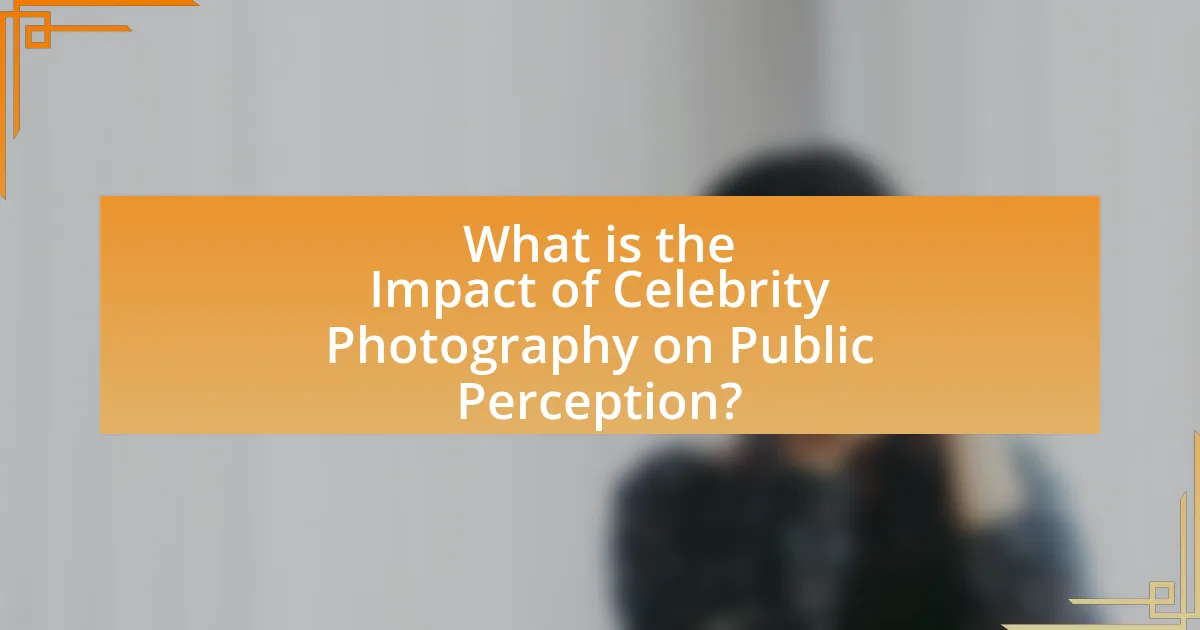The article examines the impact of celebrity photography on public perception, highlighting how it shapes societal norms, individual behaviors, and self-esteem. It discusses the psychological effects of idealized celebrity imagery, particularly among adolescents, leading to body dissatisfaction and unhealthy behaviors. The article also explores the role of social media in disseminating celebrity images, the ethical considerations surrounding privacy and consent, and the influence of celebrity photography on consumer trends and mental health. Additionally, it addresses the varying perceptions of different demographics towards celebrity imagery and offers strategies for critical engagement and media literacy to better understand its implications.

What is the Impact of Celebrity Photography on Public Perception?
Celebrity photography significantly shapes public perception by influencing societal norms and individual behaviors. The portrayal of celebrities in various contexts, such as glamorous events or candid moments, often sets standards for beauty, lifestyle, and success. Research indicates that exposure to idealized images of celebrities can lead to increased body dissatisfaction and altered self-esteem among the public, particularly among adolescents. A study published in the journal “Body Image” found that individuals who frequently view celebrity images are more likely to engage in unhealthy behaviors to achieve similar appearances. This demonstrates that celebrity photography not only reflects but also actively constructs public perceptions and aspirations.
How does celebrity photography shape societal views?
Celebrity photography shapes societal views by influencing public perceptions of beauty, lifestyle, and success. The portrayal of celebrities in various contexts, such as glamorous events or candid moments, sets standards that many individuals aspire to emulate. Research indicates that exposure to idealized images can lead to changes in self-esteem and body image among viewers, as seen in studies like “The Impact of Media Exposure on Body Image” by Tiggemann and Slater, which found a correlation between celebrity images and body dissatisfaction. Furthermore, celebrity photography often reinforces cultural norms and trends, impacting consumer behavior and societal values. For instance, the rise of social media platforms has amplified the reach of celebrity images, making them more accessible and influential in shaping public opinion and lifestyle choices.
What psychological effects does celebrity imagery have on audiences?
Celebrity imagery significantly influences audiences by shaping their self-esteem, body image, and social norms. Research indicates that exposure to idealized representations of celebrities can lead to negative self-perception and increased body dissatisfaction among viewers. For instance, a study published in the journal “Psychology of Popular Media Culture” found that individuals who frequently consume celebrity images report higher levels of body dissatisfaction and lower self-esteem compared to those with less exposure. This effect is particularly pronounced among adolescents, who are more susceptible to social comparison and the internalization of unrealistic beauty standards. Additionally, celebrity imagery can reinforce societal norms regarding success and attractiveness, leading audiences to adopt these ideals as benchmarks for their own lives.
How does celebrity photography influence trends and behaviors?
Celebrity photography significantly influences trends and behaviors by shaping public perceptions of fashion, lifestyle, and social norms. When celebrities are photographed wearing specific styles or endorsing particular products, their immense visibility can lead to widespread adoption among fans and the general public. For instance, a study published in the Journal of Consumer Research found that celebrity endorsements can increase consumer interest and purchase intentions by up to 20%. This demonstrates that the imagery associated with celebrities not only reflects current trends but also actively drives them, as individuals often seek to emulate the lifestyles and aesthetics of their favorite public figures.
Why is celebrity photography significant in modern media?
Celebrity photography is significant in modern media because it shapes public perception and influences cultural trends. The images of celebrities often serve as a reflection of societal values and aspirations, impacting how individuals view themselves and others. For instance, studies have shown that exposure to celebrity images can affect self-esteem and body image, particularly among young audiences. According to a 2019 study published in the Journal of Adolescent Health, 70% of adolescents reported feeling pressure to conform to the beauty standards set by celebrities, highlighting the powerful role that celebrity photography plays in shaping societal norms and individual behaviors.
What role does social media play in the dissemination of celebrity images?
Social media serves as a primary platform for the rapid dissemination of celebrity images, significantly influencing public perception. Through platforms like Instagram, Twitter, and Facebook, celebrities share personal moments, professional milestones, and curated images, allowing for direct engagement with fans. This immediacy and accessibility enable celebrities to shape their public personas and narratives, often bypassing traditional media filters. According to a 2021 study by the Pew Research Center, 69% of adults in the U.S. use social media, highlighting its extensive reach and impact on how celebrity images are consumed and interpreted by the public.
How do public relations strategies utilize celebrity photography?
Public relations strategies utilize celebrity photography to enhance brand visibility and credibility. By featuring well-known personalities in promotional materials, organizations can leverage the celebrities’ influence to attract attention and foster positive associations with their products or services. Research indicates that 70% of consumers are more likely to trust a brand when it is endorsed by a celebrity, demonstrating the effectiveness of this approach in shaping public perception.
What are the ethical considerations surrounding celebrity photography?
The ethical considerations surrounding celebrity photography include issues of privacy, consent, and the potential for harm. Photographers often invade the personal space of celebrities, capturing moments without their permission, which raises significant privacy concerns. For instance, the practice of paparazzi photography frequently leads to distress for the subjects, as evidenced by incidents where aggressive pursuit has resulted in dangerous situations, such as car accidents involving celebrities. Additionally, the portrayal of celebrities in unflattering or misleading contexts can perpetuate harmful stereotypes and contribute to mental health issues, highlighting the responsibility of photographers to consider the impact of their work on public perception and the individuals involved.
How does consent factor into the creation of celebrity images?
Consent is crucial in the creation of celebrity images as it determines the legal and ethical boundaries of how a celebrity’s likeness can be used. Celebrities often grant permission for their images to be captured and disseminated, which can influence public perception and brand identity. For instance, the use of a celebrity’s image in advertising typically requires explicit consent, ensuring that the individual agrees to the portrayal and context in which their likeness is presented. This consent is not only a legal requirement but also a factor that shapes the narrative surrounding the celebrity, as unauthorized use can lead to misrepresentation and public backlash. Legal cases, such as the 2018 ruling in the case of “Gordon v. Google,” highlight the importance of consent in protecting a celebrity’s right to control their image and how it is perceived by the public.
What are the implications of invasive photography on public figures?
Invasive photography significantly impacts public figures by compromising their privacy and altering public perception. This type of photography often leads to a distorted view of their lives, as images captured without consent can portray misleading narratives. For instance, studies have shown that invasive images can contribute to mental health issues among public figures, as they face constant scrutiny and judgment based on these portrayals. Furthermore, the legal implications of such photography can result in lawsuits and public backlash, affecting the reputation and career of the individuals involved. The pervasive nature of invasive photography ultimately shapes societal attitudes towards public figures, often leading to a culture of objectification and sensationalism.
How does celebrity photography affect different demographics?
Celebrity photography significantly influences different demographics by shaping perceptions of beauty, lifestyle, and social norms. For instance, research indicates that exposure to idealized images of celebrities can lead to body dissatisfaction among adolescents, particularly females, as they compare themselves to these often unattainable standards. A study published in the journal “Body Image” found that young women exposed to celebrity images reported higher levels of body dissatisfaction and lower self-esteem. Additionally, celebrity photography can impact consumer behavior across various age groups, with younger demographics often emulating the fashion and lifestyle choices of celebrities, as evidenced by a survey from the American Psychological Association, which showed that 70% of teens reported being influenced by celebrity endorsements in their purchasing decisions. Thus, the effects of celebrity photography are profound and varied, influencing self-image and consumer habits across different age and gender demographics.
What impact does celebrity imagery have on youth culture?
Celebrity imagery significantly influences youth culture by shaping ideals of beauty, lifestyle, and behavior. This influence manifests through social media platforms where young individuals often emulate the styles and attitudes of celebrities, leading to trends in fashion, language, and social norms. Research indicates that exposure to celebrity culture can affect self-esteem and body image among adolescents; for instance, a study published in the Journal of Adolescent Health found that increased consumption of celebrity media correlates with higher levels of body dissatisfaction in young people. This impact underscores the powerful role that celebrity imagery plays in defining cultural standards and expectations within youth demographics.
How do different age groups perceive celebrity photography?
Different age groups perceive celebrity photography in distinct ways, influenced by their cultural context and media consumption habits. Younger audiences, particularly those aged 18-24, often view celebrity photography as a form of entertainment and a means of connection to their favorite personalities, driven by social media platforms like Instagram and TikTok. In contrast, middle-aged individuals, typically between 35-54, may regard celebrity photography with a more critical lens, often focusing on the implications of fame and the authenticity of the images presented. Older adults, aged 55 and above, tend to perceive celebrity photography as a reflection of societal values and trends, often expressing nostalgia for past celebrities and a skepticism towards modern portrayals. Research indicates that these perceptions are shaped by factors such as exposure to media, personal experiences, and generational values, highlighting the varying significance of celebrity imagery across age demographics.
What are the potential negative effects of celebrity photography on public perception?
Celebrity photography can negatively affect public perception by promoting unrealistic standards of beauty and lifestyle. This form of media often showcases idealized images that can lead to body image issues and low self-esteem among viewers, particularly young audiences. Research indicates that exposure to such images correlates with increased dissatisfaction with one’s own appearance, as highlighted in a study published in the journal “Psychology of Popular Media Culture,” which found that individuals who frequently view celebrity images report higher levels of body dissatisfaction. Additionally, celebrity photography can create a distorted view of success and happiness, as it often emphasizes wealth and glamour, leading the public to equate these superficial traits with personal worth.
How can unrealistic portrayals in celebrity photography lead to body image issues?
Unrealistic portrayals in celebrity photography can lead to body image issues by creating unattainable beauty standards that individuals feel pressured to meet. Research indicates that exposure to idealized images can result in negative self-perception and dissatisfaction with one’s own body. A study published in the journal “Body Image” found that women who viewed heavily edited images of celebrities reported lower body satisfaction and higher levels of body shame. This phenomenon is exacerbated by social media, where such images are frequently shared, reinforcing the belief that these unrealistic standards are normal and desirable.
What are the consequences of celebrity culture on mental health?
Celebrity culture significantly impacts mental health by fostering unrealistic standards of beauty and success, leading to increased anxiety, depression, and low self-esteem among individuals. Research indicates that constant exposure to idealized images of celebrities can result in body dissatisfaction and a distorted self-image, particularly among adolescents. A study published in the journal “Body Image” found that young women who frequently engage with celebrity content report higher levels of body dissatisfaction and disordered eating behaviors. Furthermore, the pressure to emulate celebrity lifestyles can exacerbate feelings of inadequacy and social comparison, contributing to mental health issues.
How can individuals critically engage with celebrity photography?
Individuals can critically engage with celebrity photography by analyzing the context, intent, and impact of the images. This involves questioning the motivations behind the photographs, such as whether they aim to promote a specific narrative or brand. For example, studies show that celebrity images often reinforce societal standards of beauty and success, influencing public perception and self-image. By examining the framing, lighting, and composition of these photographs, individuals can uncover biases and stereotypes that may be perpetuated. Furthermore, engaging with diverse perspectives, including critiques from media scholars and cultural commentators, enhances understanding of the broader implications of celebrity imagery on societal norms and values.
What strategies can help audiences discern authenticity in celebrity images?
Audiences can discern authenticity in celebrity images by critically analyzing the context, source, and presentation of the images. Evaluating the credibility of the platform where the image is published, such as verified social media accounts or reputable news outlets, helps establish authenticity. Additionally, audiences should look for consistency in the celebrity’s public persona and the image presented; discrepancies may indicate manipulation. Research indicates that images with minimal editing and those that reflect candid moments are often perceived as more authentic, as shown in studies on visual perception and trust. Furthermore, understanding the role of public relations and marketing strategies in celebrity image crafting can provide insight into potential biases in the portrayal of celebrities.
How can media literacy improve understanding of celebrity photography’s impact?
Media literacy enhances understanding of celebrity photography’s impact by equipping individuals with critical thinking skills to analyze and interpret visual media. This skill set allows audiences to recognize the constructed nature of celebrity images, understand the influence of editing and context, and discern the underlying messages that shape public perception. Research indicates that individuals with higher media literacy are more adept at identifying biases and stereotypes in media representations, which can lead to a more nuanced view of celebrity culture and its societal implications. For instance, a study published in the Journal of Media Literacy Education found that media literacy education significantly improved participants’ ability to critically evaluate celebrity images, leading to a greater awareness of how these images can perpetuate unrealistic standards and affect self-esteem.



